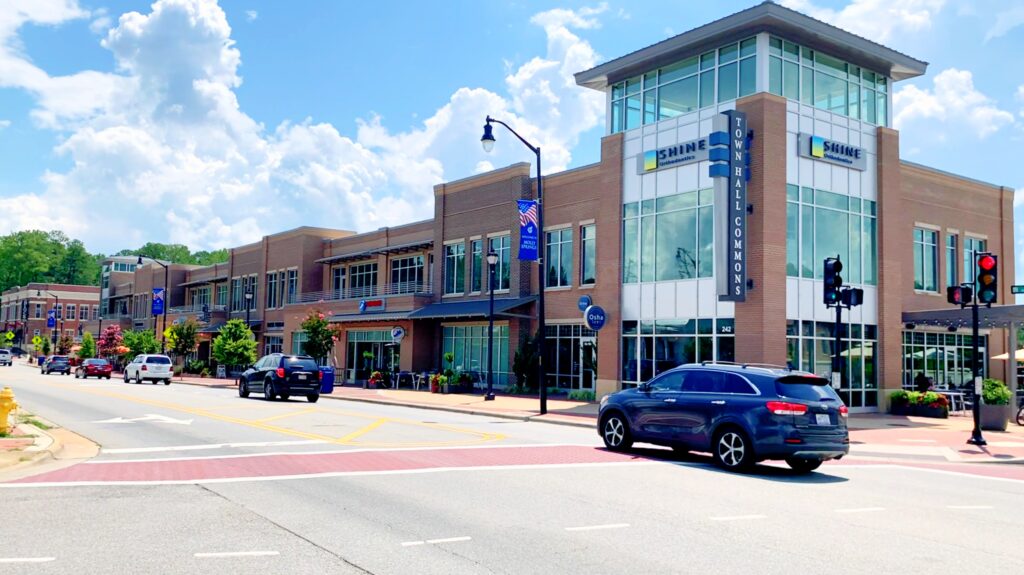How do you know when real estate prices are going to outperform the average home appreciation per year in a town…..before they actually do? I’m here to tell you that towns leave clues of their future growth. We can learn what might happen in a small town, by analyzing the growth of towns that have already blown up. We’re going to analyze the growth of Holly Springs, North Carolina. Holly Springs has experienced a 329% growth rate over the last 20 years. And it’s not for the reasons you might think.
You might be thinking that most towns have experienced crazy growth since the Covid relocation boom, but when you compare the growth of Holly Springs, North Carolina to other towns of similar size, you can see that the typical growth rate of most towns this size during the same period is somewhere in the 15% range.
Holly Springs is absolutely a growth outlier, and there is a secret reason why. Of course, not all towns are going to have this kind of insane growth, but if you’re deciding where to buy a home, or where to buy an investment property, we can learn from what happened in Holly Springs to understand where the next great currently undervalued boomtown might be.
23 years ago, town leaders learned something that changed the trajectory of Holly Springs forever. As late as 1990, the population of Holly Springs was only about 900 people. At that time the towns to the north and south of it, Fuquay Varina and Apex, had populations around 5000.
All these towns were benefiting from the growth of the Research Triangle Park, a large business park focused around technology and life science companies. Which was attracting workers to the area. But Holly Springs hadn’t had the same growth as the others. Back then, almost nothing existed in Holly Springs. There was no downtown area, no real shopping district and no community spaces. Just 20 minutes away, was the state capitol, Raleigh, a charming, friendly city with multiple colleges and universities, low crime, museums and good shopping. All of these things were fueling the growth of neighboring Cary, Apex and Fuquay Varina. Why was a town so close to such a desirable city so undervalued? And how did it spring up out of nothing to become one of the top relocation spots in the state?
I’ve discovered three things that Holly Springs has done that has made it an absolute powerhouse for business growth and appreciating real estate values. The third one is the hardest to pull off. It’s the one thing none of the neighboring communities even thought of. And it’s the reason Holly Springs growth rate eventually exceeded the surrounding areas. It’s funny because the neighboring communities didn’t think Holly Springs could do it. But they did and the results were shocking. Let’s take a look at Holly Springs path to growth.
Be in a great location
We’ve all heard the real estate mantra, location, location, location. And location is really important. To understand why Holly springs initially floundered, even with it’s great location, and even though other towns were growing, we need a little backstory.
The town of Holly Springs began as a small village that started to grow because of its location. The important feature back then was water. And the spring surrounded by Holly Trees was the first hot spot in town.
The town grew and thrived until the Civil War, when almost everyone who hadn’t died in the war, abandoned the town and by 1871, Holly Springs was described by a passer through as a deserted village. A few years later, a business man named George Benton Alford saw an opportunity in Holly Springs, again, due to its great location between Apex and Fuquay-Varina. He purchased a 38 room mansion and moved his successful mercantile store to the area. And Holly Springs began to grow again.
Then came World War 1, the Great Depression and WW2. With each successive catastrophe, Holly Springs wasn’t quite established enough to maintain its structure. Each setback destroyed the fledgling town, and people moved away. These setbacks combined with a great location are the kinds of things you want to look for in an up and coming town.
A setback like this happened on a much smaller scale, in Cary, North Carolina, a city often touted as the best place to live in the country. Back before the 2008 housing crash, Cary had started its climb to trend setting city, but it got delayed by circumstances and a lot of the development plans they had put into action, got tabled until better times. These things happen, but again, those are great opportunities.
Holly Springs setbacks kept happening at just the wrong time.. Then Finally in the 1960’s, things started to change. Research Triangle Park was established in 1959. Today it is still the areas’ largest employer. RTP really began to take off in 1965 and the town of Cary, right next door to RTP began to see the benefits immediately. Apex, which was right next door to Cary, also began to grow as RTP expanded. Even Fuquay to the south of Holly Springs benefitted. But Holly Springs? Nope. Apex grew to 2000 people. Fuquay grew to 3000 people. But Holly Springs only had 300 people. The reason? Poop!
Holly Springs didn’t have the utility infrastructure to grow. It wasn’t until 1987 that the town built its first sewage treatment plant. But taking care of the poop made all the difference!
Amenities

Location is important. But without something else, a town won’t grow. You’ve got to leverage your location. If a town has a great location, they still have to create a place that people want to live. You’re only going to grow so much if you don’t have sewage treatment, but that’s just the beginning.
In the 1990’s after building the sewage treatment plant, Holly Springs experienced its first taste of success. From 1995 to 2000 Holly Springs population made its first huge jump, skyrocketing over 300% from 3000 people to 10,000 people in just 5 years.
At the same time this was happening, the town was developing a master plan that would be the foundation of its success. Holly Springs’ vision was right on. They knew what Americans really wanted in a town and those early documents show 3 things I think had the biggest impact on people seeing the town as a desirable place to live:
- Wanted to give all residents the ability to live within walking distance of a neighborhood commercial center and a central civic space.
- They wanted to create a green infrastructure to provide all residents with access to trails and open spaces, protect woodlands and physically unite the town by connecting the trails, sidewalks and open spaces.
- They wanted to allow some larger commercial stores for convenience, but still protect the character of the town.
These are all great things that truly make a town an incredible place to live. But in order to experience the astounding growth they wanted, there was one more thing they had to do. And this was the thing that nobody else was doing.
Economic Development
Now, suburban sprawl is a huge issue in the US. And one of the biggest contributors to it is bedroom communities that exist for no other reason than to provide housing for people who work in other cities. Holly Springs didn’t want this.
And this is when Holly Springs did something really smart. They hired a consulting firm to perform a branding study. This study told the town council what they already suspected. Holly Springs was a really good location for life science companies. They had plenty of land to build on and it was affordable, and the town’s proximity to a ready pool of scientists at the local universities, provided easy access to high quality talent. But what large corporation is going to move their headquarters to a tiny little town of less than 20,000 people? Companies usually look for cities that will be most likely to attract the best employees. In the early 2000’s, there was barely a restaurant in Holly Springs. The marketing department had their work cut out for them.
Surrounding towns didn’t think Holly springs could actually pull it off. And to an extent they were right. Before a business of the caliber they were trying to attract would actually move their headquarters to Holly Springs, they needed to see some proof that the town could be the kind of community their higher income employees would want to live.
And it wasn’t yet. But they did have a plan in place and had taken the first steps to implement that plan. And the plan was enough for the first corporation to locate their headquarters in Holly Springs, because to everyone’s surprise In 2006, the same year the Holly Springs library and cultural center were built, pharmaceutical company novartis, chose Holly Springs as the base for the first flu cell culture manufacturing facility in the US. They opened in 2009. Multiple life sciences companies followed and today, Holly Springs has a median home price of just under $600,000, a 271% increase in property value during that period. And almost 200,000 higher than the county as a whole.
Now is a really good time to be on the lookout for up and coming towns that are getting ready to boom.

